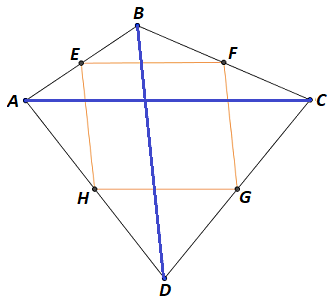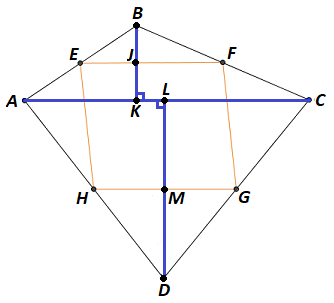Quadrilateral Midpoint Areas
If you join the midpoints of adjacent sides of a rectangle, a new quadrilateral is formed with half the area of the original rectangle:

If you join the midpoints of adjacent sides of any quadrilateral, will the newly formed quadrilateral always have half the area of the original quadrilateral?
This section requires Javascript.
You are seeing this because something didn't load right. We suggest you, (a) try
refreshing the page, (b) enabling javascript if it is disabled on your browser and,
finally, (c)
loading the
non-javascript version of this page
. We're sorry about the hassle.
2 solutions
Nice proof, (so far). This is known as Varignon's theorem .
Yeah, I was also wondering about concave quadrilaterals.
Let A B C D be a quadrilateral, and E F G H be the new quadrilateral that is formed by joining the midpoints of adjacent sides.

Then each side of E F G H is a midsegment of a triangle whose base is one of the diagonals of A B C D and whose sides are two of the sides of A B C D . By the triangle midsegment theorem, E F ∣ ∣ A C and G H ∣ ∣ A C , so E F ∣ ∣ G H . Similarly, F G ∣ ∣ B D and E H ∣ ∣ B D , so F G ∣ ∣ E H . Therefore, E F G H must be a parallelogram.
Now let B K be the altitude of △ A B C and J the intersection of B K and E F (for concave quadrilaterals, let A be the concave angle, and extend E F for the intersection point J ). Similarly, let D L be the altitude of △ A C D and M the intersection of D L and G H . Let p = E F , q = J K , and r = L M .

Once again by the triangle midsegment theorem, E F = 2 1 A C , and since p = E F , A C = 2 p . Since △ B E F ∼ △ B A C and corresponding sides E F and A C have a 2 1 ratio, the heights B J and B K also have a 2 1 ratio, and since q = J K , B K = 2 q . Similarly, since r = L M , D L = 2 r .
The area A A B C D of quadrilateral A B C D is equivalent to the combined areas of △ A B C and △ A D C , which are 2 1 ⋅ 2 p ⋅ 2 q = 2 p q and 2 1 ⋅ 2 p ⋅ 2 r = 2 p r respectively, so A A B C D = 2 p q + 2 p r = 2 ( p q + p r ) . The area A E F G H of parallelogram E F G H is A E F G H = p ( q + r ) = p q + p r . Therefore, A E F G H = 2 1 A A B C D .
The above argument can be made for any quadrilateral A B C D , whether it be a square, rectangle, concave, or convex. Therefore, if the midpoints of adjacent sides of any quadrilateral are joined, a parallelogram is always formed that is always half of the area of the original quadrilateral.
Note: this is an incomplete proof, for I have yet to figure out how to apply this to concave quadrilaterals.
Let us have quadrilateral A B C D with the new "midpoint quadrilateral" W X Y Z :
Now, analyze the four triangles and their side lengths. Since W is the midpoint of A B , that means A W ≅ B W . Note that we can apply this to all of the sides. Knowing this, we can the reflect each triangle over its "midpoint side" ( △ A W Z over W Z , etc.):
Since the sides don't overlap due to their congruence, this is a valid transformation. This will put all of the triangles on top of W X Y Z , which means the areas are the same. Since the areas are the same, 2 ⋅ A W X Y Z = A A B C D A W X Y Z = 2 1 ⋅ A A B C D